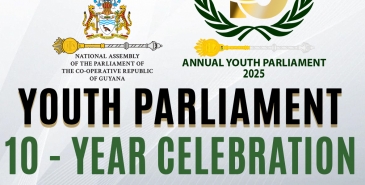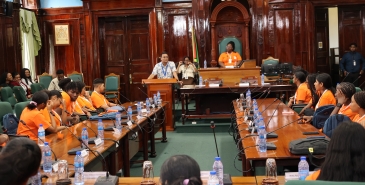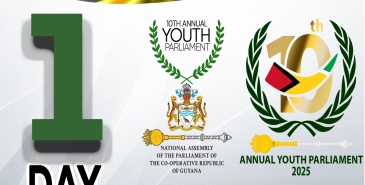National Day of Villages
Speech delivered at: 63rd Sitting - Tenth Parliament - 07 November, 2013
07 November, 2013
24280
NATIONAL DAY OF VILLAGES
Minister of Culture, Youth and Sport [Dr. Anthony]: Thank you very much Mr. Speaker. Hon. Members, I rise on behalf of the Government to offer a few remarks on this important motion of declaring a National Day of Villages.
Conceptually the notion of having such a day designated is quite commendable. As villagers have played and continues to play a significant role in the development of human civilisation. Villages are not just a place to live, but a place where people are socialised, where people work, play and develop into a community. Villages develop a persona. It gives its inhabitant a sense of identity, a sense of belonging, a way to organise and a way to inculcate values and a way to express one’s self. It is perhaps these enduring attributes that was upper most in Mahatma Ghandi’s mind when he remarked, “The sole of India is in its villages.”
In Guyana, like the rest of the world, we have a long tradition of villages. In pre-colonial and colonial times to contemporary times, we know of the various villages that evolved and grew across our country. The indigenous population of our country would have established some of the earliest villages. We have evidence of these early settlements from archaeological evidence, such as shell mounds that we can find in various parts of Guyana.
We also have numerous accounts of European explorers who had ventured into the Interior. Their descriptions of settlement, customs and practices have all added to our understanding of these communities. These communities can truly be described as the very first villages in Guyana.
In post emancipation we have seen the establishment of African villages. Freed slaves established these villages by communal, propriety or individual purchases. On the 7th of November, 1839, as was already said, 83 labourers from the surrounding villages of Dochfour, Anns Grove, Hope, Paradise and Enmore bought Plantation Northbrook – a 500 acres coffee plantation for BG$10,000. It was said that they paid BG$6000 in cash and paid the remaining BG$4000 three weeks later.
Indeed, this was followed by similar purchases of free people, which included Golden Grove, a 500 acres plantation purchased by 14 persons for about BG$1716. There is St. John’s, the eastern half of Perseverance, Leitchfield, Beterverwagting, New Orange Nassau and the Friendship Plantations. These are just about a few examples of plantations that were purchased by freed people.
Allan Young, one of our historians, pointed out, in “Some milestones and village history”, at page five, and he said this:
“In British Guiana, in point of fact between 1839 when the village movement had its beginnings and 1848 when it reached the end of its fullness, the stream of immigrants from the estate to village showed a steady increase. By 1842 they totalled 16,000; by 1848 they had reached 44,000. From then, up the end of 1856 the increase was a mere 10,000, but in the later year the village population already represented nearly half of the population of the entire coastal belt.”
With this movement of persons away from the estate, the plantocracy sought new labour sources and we know for example Indian Indentureship, which was ushered in on the 5th May, 1838. The immigrants were given a five year contract. At the end of their contract they were supposed to be given a return passage to Indian.
Planters wanted to encourage immigrants to stay, so one of the things they came up with was to swap their return passage in lieu of land. As was said again in 1865, one of the first experiments of giving lands to immigrants started with the Chinese settlement that was at Hopetown in the Kamuni Creek. Initially it was a prosperous settlement, but it eventually collapsed after one of its founding members disappeared.
An experimental scheme with East Indians was started at Nooten Zuil, in 1871, but was unsuccessful. In 1881, another such scheme was started at Hust t’ Dieren, this too was not very successful and on the 13th of April, 1896, Governor Charles Lee appointed a Commission to inquire into the best means by which Indian immigrants might be persuaded to commute their right to return passage and settle in Guyana. This report led to the colonial Government making another attempt at land in lieu for return passage scheme and this resulted in the development of Helena, where they settle, about 1206 persons, there in 1898. After moderate successes another scheme was implemented in 1899 at Whim, in Berbice and at Marias Pleasure in Wakenaam. In 1902 another scheme was developed in Bush Lot, in West Berbice.
Apart from these schemes, Indian immigrants started to buy lands and to establish their own communities. This process is all captured in full detail in Dr. Dale Bisnauth’s book, “The settlement of Indians in Guyana 1890-1930.” This resettlement process started perhaps another round of village development in Guyana.
I went through that brief history or overview just to say that in a multi-ethnic society, like ours, every group would have contributed to the development of villages in their own unique way. It is my humble view that a National Day of Villages must therefore honour these varied contributions that occurred throughout our history and by our various ancestors.
I note that the date purposed for the National Day of Villages corresponds to the date of Victoria Village’s purchase. This concept of a National Day of Villages is perhaps a much larger one that the Victoria Village and I wonder about the appropriateness of the date. I have no problem in celebrating the anniversary of this historic purchase. I would like because today is the 7th day of November, to join and I think all of us should, in congratulating the descendents of the purchasers on the 174th Anniversary of Victoria Village.
From time to time we ourselves in the Ministry have assisted the residents of the Victoria Village to organise various activities, to highlight this important milestone. I am sure that for example in 2014 we will work with all the stakeholders to celebrate the 175th Anniversary. It is difficult to see why a National Day of Villages should be tied to this particular date. I suppose that one can argue that the Victoria Village is indeed unique. Some might say it is the first African village; some might say it is the first village purchased by Africans and it is the first communal village.
I guess most of us know this and have accepted this for some time now, as implied by the motion. If it is that clear, then the case perhaps is already made. But is it really that clear? Some historians have said that the correct interruption of historic facts would find us wanting and that our history might be slightly different from what we have become accustomed to, by popular beliefs.
If we examine this claim that Victoria Village was the first African village in British Guiana, this is not true. The honour and distinction of the first freed African should go to the Winkel Village in New Amsterdam. The records would should that the notice of manumission was read to the 298 Winkel negros, on the 22nd October, 1821. We can get that from “The history of Africans in Guyana”, by James Graham Cruickshank. I have the relevant passages, but I would not read them.
On 1st November, 1831, they were given the deed of manumission. This would mark perhaps 182 years since the Winkel negros were freed. These freed people established the first freed African communities, at least eight years prior to Victoria Village.
In addition to Winkel Village, there were other African villages that existed before the Victoria Village, as Allan Young pointed out, again, in “Some milestones in village history” on page 6,
“Up to the middle of 1839, except for a small hamlet at Mahaicony ferry, there were also two villages to be found on the entire coastland of British Guiana, one at Mahaica and the other one at Plantation Aberdeen on the Essequibo Coast.”
Mahacia must have been a very thriving village, as Robert Schomburgk, in his book, “A description of British Guiana – Geographical and Statistical, establishing its resources and capabilities.” on page 79, had this to say about Mahaica.
“The village of Mahaica built on the West Bank of the river of Mahaica with a houses on the Eastern Bank, is the most striving village in rural districts of British Guiana. It possesses a church, Wesleyan Chapel and an apotecari shop and several stores for sale of merchandise. The number of houses is estimated at 80, with a population of 600 souls.”
Historians today still debate whether Mahaica was a communal village or a propriety village.
It is often claimed that Victoria is the first African village that was bought by freed slaves. In fact most of our text books perhaps would have stated so. This has now crept into our collective minds and has been reinforced by plays such as “The Purchase” and many other cultural things that we have but again some historians have claimed that Den Amstel was purchased before Victoria. They have based their assertion on primary source documents. A petition dated February 1846 implicitly stated:
“Your petitioners in the month of October, 1838, purchased of Mr. Thomas Bagott and James Holmes, individually and separately, each for himself, a number of lots of land [in all 60] forming part of Plantation Den Amstel, West Coast of Demerara, that your petitioners did, individually and separately and each for himself paid to the said Mr. Bagott and Holmes the sum of $110 each and further erect on the said lots buildings of considerable value.”
From the content of this petition it is clear that freed African slaves, the petitioners in this document actually bought Den Amstel before Victoria. Historically, therefore, there were several African villages that existed before the 7th November, 1839. These were the Winkel Village, Mahaicony, Mahaica, Aberdeen and Den Amstel and I therefore wonder why the founding dates for these communities were bypassed in preference to the purchase date of Victoria. Perhaps the Hon. Leader of the Opposition would be able to better explain the preference and rationale for this date. I believe that, based on chronology, we have several options before us.
Again, as we celebrate village anniversaries, I am sure that the relevant entities would be happy to make commemorative items. The post office, of course, would have a long tradition of printing commemorative stamps and a notable example being in 1931, commemorating the 100th anniversary of the colony formation; there are many examples. In 1985 commemorating the 150th anniversary of the abolition of slavery, from 1834-1984, there were four beautiful stamps that were done – a 25 cent stamp that shows the 1763 rebellion and Cuffy, a 60 cent stamp with scenes of Damon’s execution and the Parliament Building, a $1.30 stamp of the 1833 Demerara Uprising and the Bethel Chapel and a $1.60 stamp with the vessel of Arden one of the ships that brought the first set of enslaved Africans to Guyana and we can go on to list other commemorative stamps. The post office has always been very receptive to helping us celebrate national milestones as exemplified by the stamp records that they have and I am confident that they will be willing to assist us in celebrating the 175th anniversary of Victoria Village. Similarly the Bank of Guyana has a commendable track record on issuing commemorative coins. The most recent coins issues were coins to highlight the 250th Anniversary of the Berbice Slave Rebellion and the 175th Anniversary of the arrival of Indian Indentured Immigrants and I am sure that the Bank of Guyana would always be willing to assist us in commemorating significant historic milestones in coinage.
I recognise the contribution of our ancestors, the role in development of villages across Guyana and the significant role that these villages have played in national development and I think that we deserve to highlight this and celebrate this effort. We should use the pioneering and enterprising spirit of our ancestors when we have these celebrations. I, therefore, would like to say that a national day of villages must truly celebrate all of our villages, all of our ancestors and all of their contributions. Anything short of that, I am afraid, would not be national. Thank you very much. [Applause]
Speech delivered by:
What's New

17 August, 2025
10th Annual Youth Parliament Closes: Celebrating a Decade of Impact, Excellence, and Youth Empowerment10th Annual Youth Parliament Closes: Celebrating a Decade of Impact, Excellence, and Youth Empower

13 August, 2025
Youth Parliamentarians Assemble for Grand Rehearsals for the 10th Annual Youth Parliament

12 August, 2025
10th Annual Youth Parliament Kicks Off – Young Voices, Bold Ideas, Bright Futures!

11 August, 2025
10th Annual Parliament Kicks off tomorrow

